A New Single-Leg Lower-Limb Rehabilitation Robot: Design, Analysis and Experimental Evaluation
Abstract
1. Introduction
2. Materials and Methods
2.1. Mechanical Design
2.1.1. Lifting Mechanism and Hip Joint Assembly Design
2.1.2. Exoskeleton Mechanical Leg Structural Design
2.1.3. Limit Block and Limit Chute Design
2.2. Sensor and Control System Design
3. Trajectory Planning and Control Strategy
3.1. Kinematic Analysis
3.2. Rehabilitation Robot Training Trajectory Planning
3.3. Active Training Control System Design
3.4. Evaluation of Active Participation Based on Physiological Signals
4. System Verification and Performance Analysis
5. Conclusions and Future Work
- (1)
- For the S-LLRR, the end position of the mechanical leg was calculated first, then the trajectory planning based on CPM training mode was carried out and the curves of the rotation angle, angular velocity, and angular acceleration of the hip joint and knee joint were simulated. Through the above analysis, the rationality of mechanism design and trajectory planning was proven.
- (2)
- The workspace of S-LLRR was simulated and analyzed, proving that it could meet the training needs of patients. The prototype system was built, and the end-track tracking of the experiment showed that the fluctuation along the Y-axis is all within the range of 137.5–141 mm and error was less than 2 mm compared with the preset value, proving that S-LLRR achieved relatively high motion accuracy.
- (3)
- The patient fatigue test was carried out using the evaluation model of active participation based on physiological signals, and the accuracy rate of fatigue prediction reached 85%, which proved that the evaluation model of active participation has a high accuracy rate. It can be used as an evaluation standard for the rehabilitation performance of S-LLRR active training, and as a basis for medical students to formulate training plans for patients.
Author Contributions
Funding
Data Availability Statement
Conflicts of Interest
References
- Feigin, V.L.; Stark, B.A.; Johnson, C.O.; Roth, G.A.; Bisignano, C.; Abady, G.G.; Hamidi, S. Global, regional, and national burden of stroke and its risk factors, 1990–2019: A systematic analysis for the Global Burden of Disease Study 2019. Lancet Neurol. 2021, 20, 795–820. [Google Scholar] [CrossRef]
- Markus, H.S. Reducing disability after stroke. Int. J. Stroke 2022, 17, 249–250. [Google Scholar] [CrossRef]
- Zhang, F.; Hou, Z.G.; Cheng, L.; Wang, W.; Chen, Y.; Hu, J. Ileg—A lower limb rehabilitation robot: A proof of concept. IEEE Trans. Hum.-Mach. Syst. 2016, 46, 761–768. [Google Scholar] [CrossRef]
- Stewart, S.; MacIntyre, K.; Capewell, S.; McMurray, J.J. Heart failure and the aging population: An increasing burden in the 21st century? Heart 2003, 89, 49–53. [Google Scholar] [CrossRef]
- Flansbjer, U.B.; Holmbck, A.M.; Downham, D.; Patten, C.; Lexell, J. Reliability of gait performance in men and women with hemiparesis after stroke. J. Rehabil. Med. 2005, 37, 75–82. [Google Scholar]
- Aurich, T.; Gut, A.; Labruyere, R. The FreeD module for the Lokomat facilitates a physiological movement pattern in healthy people—A proof of concept study. J. Neuroeng. Rehabil. 2019, 16, 1–13. [Google Scholar]
- Akdoğan, E.; Adli, M.A. The design and control of a therapeutic exercise robot for lower limb rehabilitation: Physiotherabot. Mechatronics 2011, 21, 509–522. [Google Scholar] [CrossRef]
- Yin, Q.; Hu, A.; Li, Q.; Wei, X.; Yang, H.; Wang, B.; Zhang, G. Compound lower limb vibration training rehabilitation robot. Concurr. Comput. Pract. Exp. 2021, 33, e6059. [Google Scholar] [CrossRef]
- Wang, Y.; Xu, Q. Design and testing of a soft parallel robot based on pneumatic artificial muscles for wrist rehabilitation. Sci. Rep. 2021, 11, 1273. [Google Scholar] [CrossRef]
- Wang, K.Y.; Yin, P.C.; Yang, H.P.; Tang, X.Q. The man-machine motion planning of rigid-flexible hybrid lower limb rehabilitation robot. Adv. Mech. Eng. 2018, 10, 16878140–18775865. [Google Scholar] [CrossRef]
- Barbosa, A.M.; Carvalho, J.C.M.; Goncalves, R.S. Cable-driven lower limb rehabilitation robot. J. Braz. Soc. Mech. Sci. Eng. 2018, 40, 1–11. [Google Scholar] [CrossRef]
- Tomisaki, H. Development of portable therapeutic exercise machine TEM LX2 type D. In 36th International Symposium on Robotics Symposium Digest; At the Keidanren Kaikan in Tokyo; Emerald Group Publishing Limited: West Yorkshire, UK, 2005. [Google Scholar]
- Wang, L.; Tian, J.; Du, J.; Zheng, S.; Niu, J.; Zhang, Z.; Wu, J. A hybrid mechanism-based robot for end-traction lower limb rehabilitation: Design, analysis and experimental evaluation. Machines 2022, 10, 99. [Google Scholar] [CrossRef]
- Zhang, X.; Yue, Z.; Wang, J. Robotics in lower-limb rehabilitation after stroke. Behav. Neurol. 2017, 2017, 1–13. [Google Scholar] [CrossRef]
- Mayetin, U.; Kucuk, S. Design and Experimental Evaluation of a Low Cost, Portable, 3-DOF Wrist Rehabilitation Robot with High Physical Human–Robot Interaction. J. Intell. Robot. Syst. 2022, 106, 65. [Google Scholar] [CrossRef]
- Curcio, E.M.; Carbone, G. Mechatronic design of a robot for upper limb rehabilitation at home. J. Bionic Eng. 2021, 18, 857–871. [Google Scholar] [CrossRef]
- Gallagher, J.F.; Sivan, M.; Levesley, M. Making Best Use of Home-Based Rehabilitation Robots. Appl. Sci. 2022, 12, 1996. [Google Scholar] [CrossRef]
- Yang, Q.; Xie, C.; Tang, R.; Liu, H.; Song, R. Hybrid active control with human intention detection of an upper-limb cable-driven rehabilitation robot. IEEE Access 2020, 8, 195206–195215. [Google Scholar] [CrossRef]
- Gui, K.; Liu, H.; Zhang, D. Toward multimodal human–robot interaction to enhance active participation of users in gait rehabilitation. IEEE Trans. Neural Syst. Rehabil. Eng. 2017, 25, 2054–2066. [Google Scholar] [CrossRef]
- Hu, J.; Meng, Q.; Zhu, Y.; Zhang, X.; Wu, W.; Yu, H. Spring damping based control for a novel lower limb rehabilitation robot with active flexible training planning. Technol. Health Care 2022, 31, 565–578. [Google Scholar] [CrossRef]
- Khan, M.A.; Saibene, M.; Das, R.; Brunner, I.; Puthusserypady, S. Emergence of flexible technology in developing advanced systems for post-stroke rehabilitation: A comprehensive review. J. Neural Eng. 2021, 18, 061003. [Google Scholar] [CrossRef]
- Meng, W.; Liu, Q.; Zhou, Z.; Ai, Q. Active interaction control applied to a lower limb rehabilitation robot by using EMG recognition and impedance model. Ind. Robot Int. J. 2014, 41, 465–479. [Google Scholar] [CrossRef]
- Sheng, B.; Tang, L.; Moosman, O.M.; Deng, C.; Xie, S.; Zhang, Y. Development of a biological signal-based evaluator for robot-assisted upper-limb rehabilitation: A pilot study. Australas. Phys. Eng. Sci. Med. 2019, 42, 789–801. [Google Scholar] [CrossRef]
- Zhou, J.; Yang, S.; Xue, Q. Lower limb rehabilitation exoskeleton robot: A review. Adv. Mech. Eng. 2021, 13, 16878140211011862. [Google Scholar] [CrossRef]
- Wang, X.; Liu, G.; Feng, Y.; Li, W.; Niu, J.; Gan, Z. Measurement method of human lower limb joint range of motion through human-machine interaction based on machine vision. Front. Neurorobot. 2021, 15, 753924. [Google Scholar] [CrossRef]
- Roaas, A.; Andersson, G.B. Normal range of motion of the hip, knee and ankle joints in male subjects, 30–40 years of age. Acta Orthop. Scand. 1982, 53, 205–208. [Google Scholar] [CrossRef]
- Beckerle, P.; Salvietti, G.; Unal, R.; Prattichizzo, D.; Rossi, S.; Castellini, C.; Bianchi, M. A human–robot interaction perspective on assistive and rehabilitation robotics. Front. Neurorobot. 2017, 11, 24. [Google Scholar] [CrossRef]
- Grosu, V.; Grosu, S.; Vanderborght, B.; Lefeber, D.; Rodriguez-Guerrero, C. Multi-axis force sensor for human–robot interaction sensing in a rehabilitation robotic device. Sensors 2017, 17, 1294. [Google Scholar] [CrossRef]
- Tian, J.; Wang, H.; Zheng, S.; Ning, Y.; Zhang, X.; Niu, J.; Vladareanu, L. sEMG-Based Gain-Tuned Compliance Control for the Lower Limb Rehabilitation Robot during Passive Training. Sensors 2022, 22, 7890. [Google Scholar] [CrossRef]
- Shen, C.; Liu, F.; Yao, L.; Li, Z.; Qiu, L.; Fang, S. Effects of MOTOmed movement therapy on the mobility and activities of daily living of stroke patients with hemiplegia: A systematic review and meta-analysis. Clin. Rehabil. 2018, 32, 1569–1580. [Google Scholar] [CrossRef]
- Noble, S.; Pearcey, G.E.; Quartly, C.; Zehr, E.P. Robot controlled, continuous passive movement of the ankle reduces spinal cord excitability in participants with spasticity: A pilot study. Exp. Brain Res. 2019, 237, 3207–3220. [Google Scholar] [CrossRef]
- Wu, Q.; Wang, X.; Chen, B.; Wu, H. Patient-active control of a powered exoskeleton targeting upper limb rehabilitation training. Front. Neurol. 2018, 9, 817. [Google Scholar] [CrossRef] [PubMed]
- Horton, S.; Mares, K.; Coull, N.; Poland, F. On the character and production of active participation in neuro-rehabilitation: An Actor-Network perspective. Sociol. Health Illn. 2017, 39, 1529–1541. [Google Scholar] [CrossRef] [PubMed]
- Jahromi, M.G.; Parsaei, H.; Zamani, A.; Dehbozorgi, M. Comparative analysis of wavelet-based feature extraction for intramuscular EMG signal decomposition. J. Biomed. Phys. Eng. 2017, 7, 365. [Google Scholar]
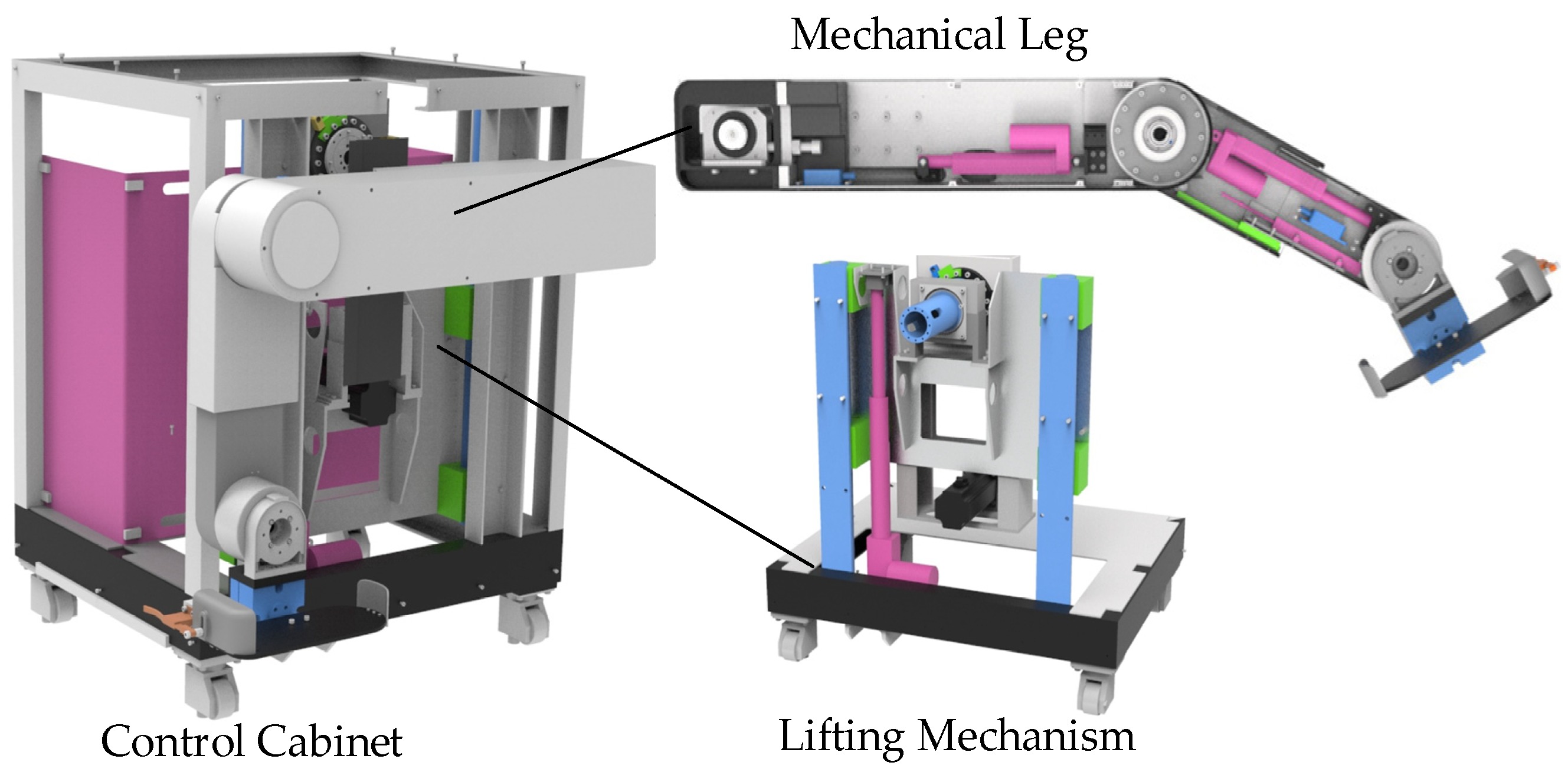
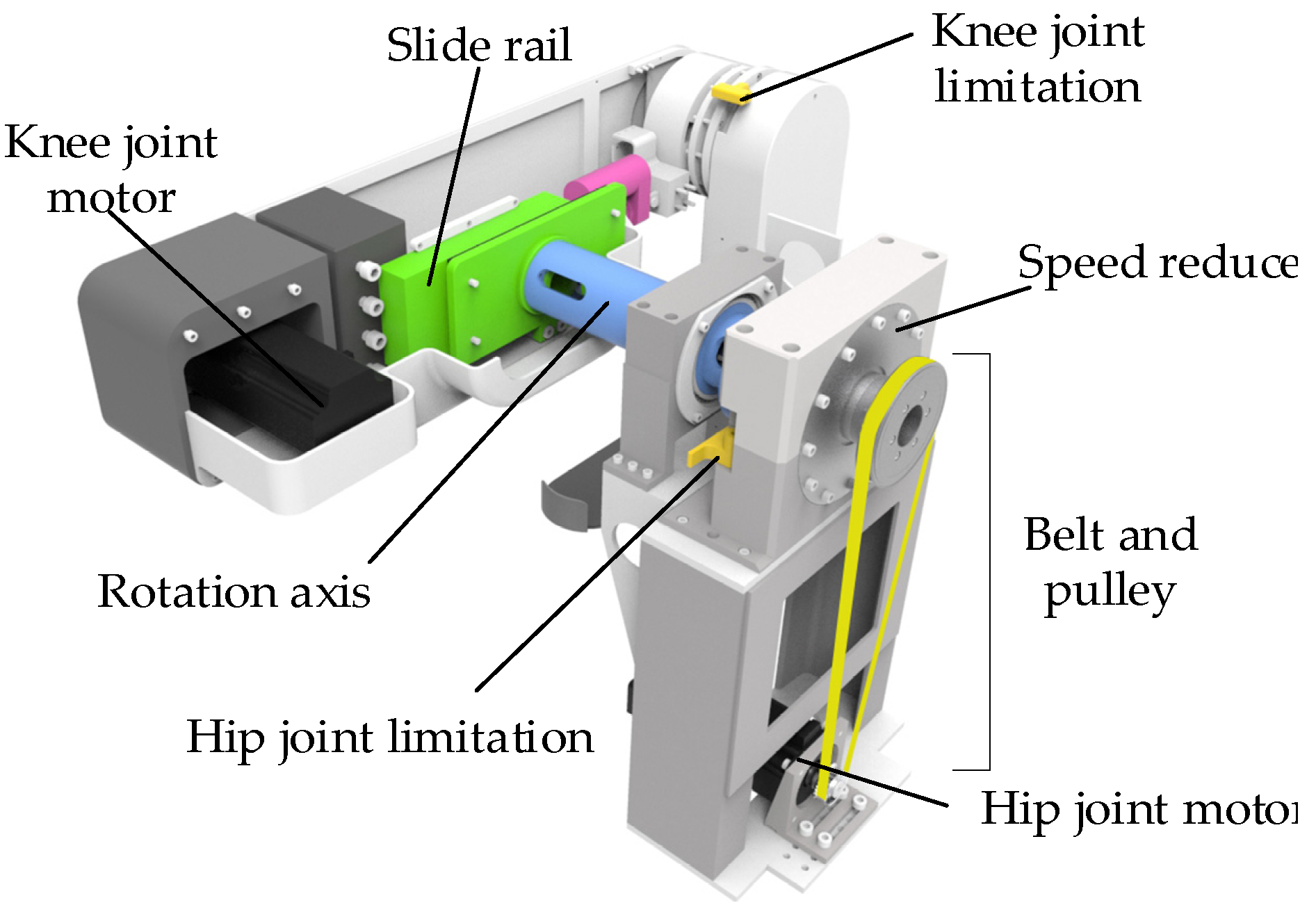
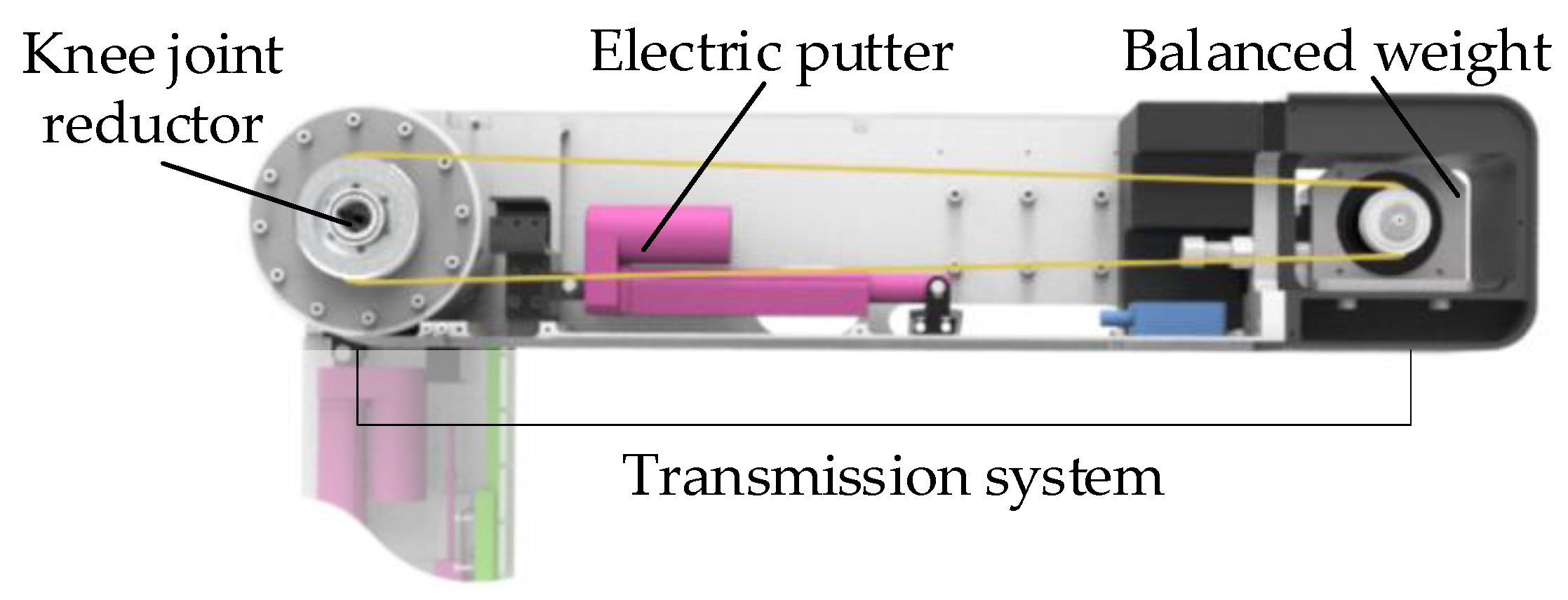
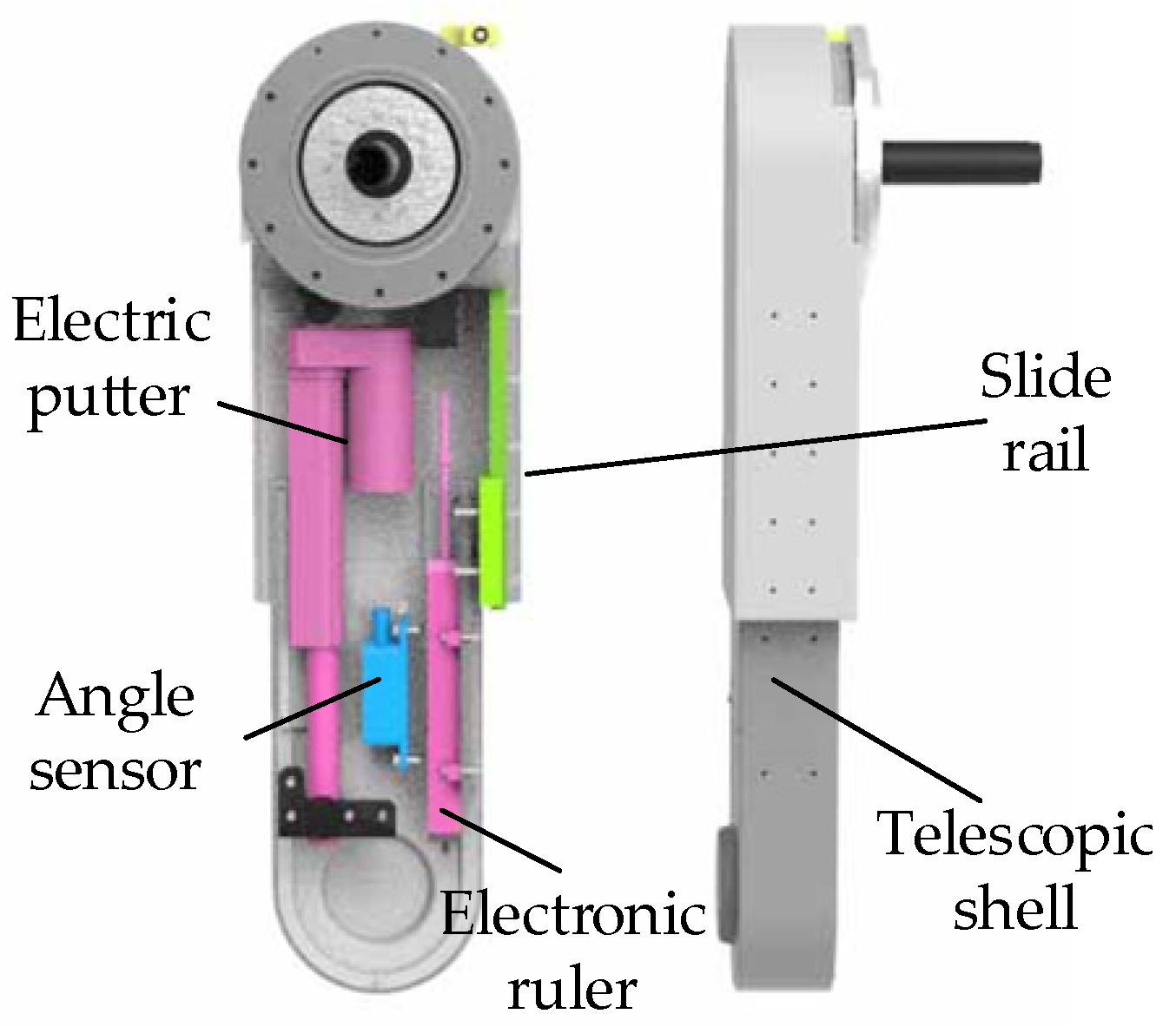
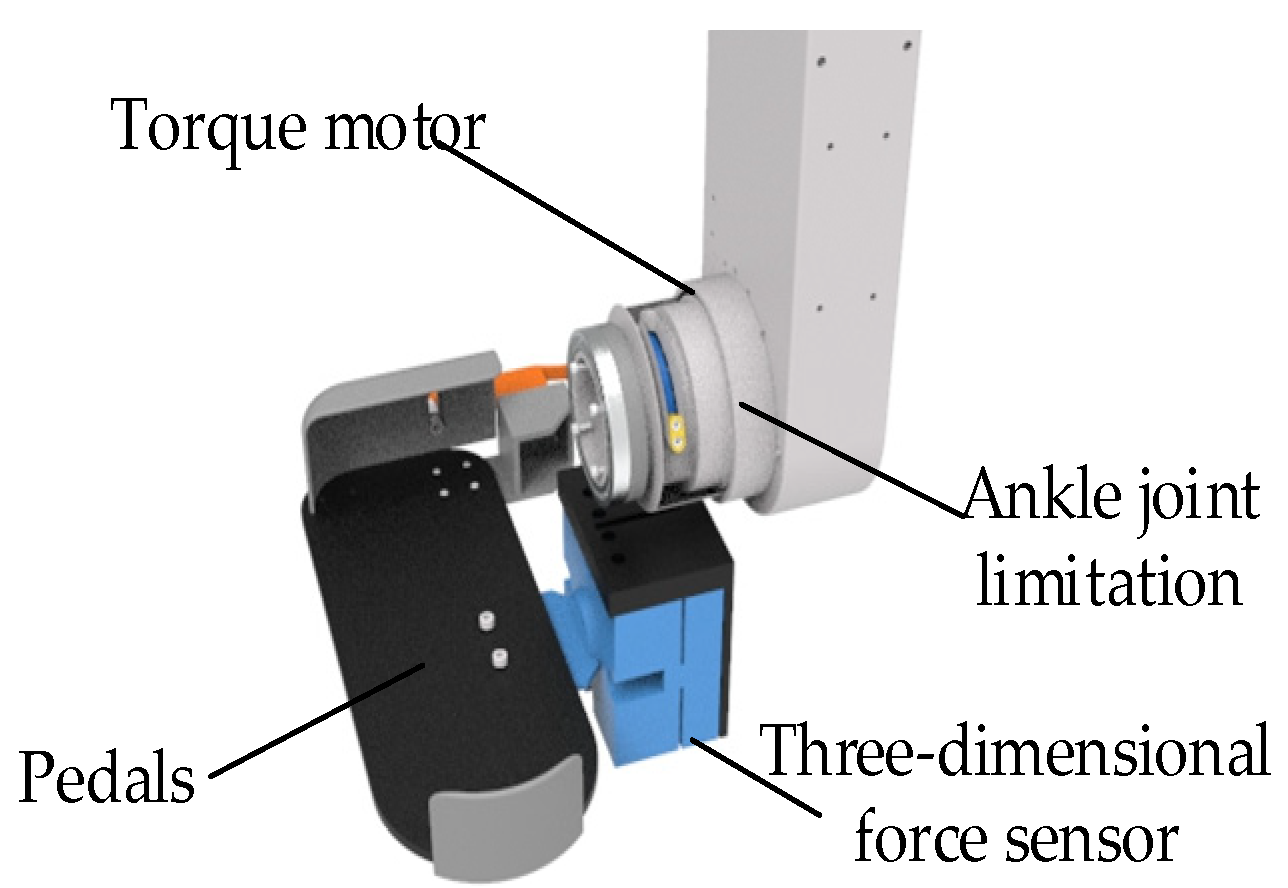
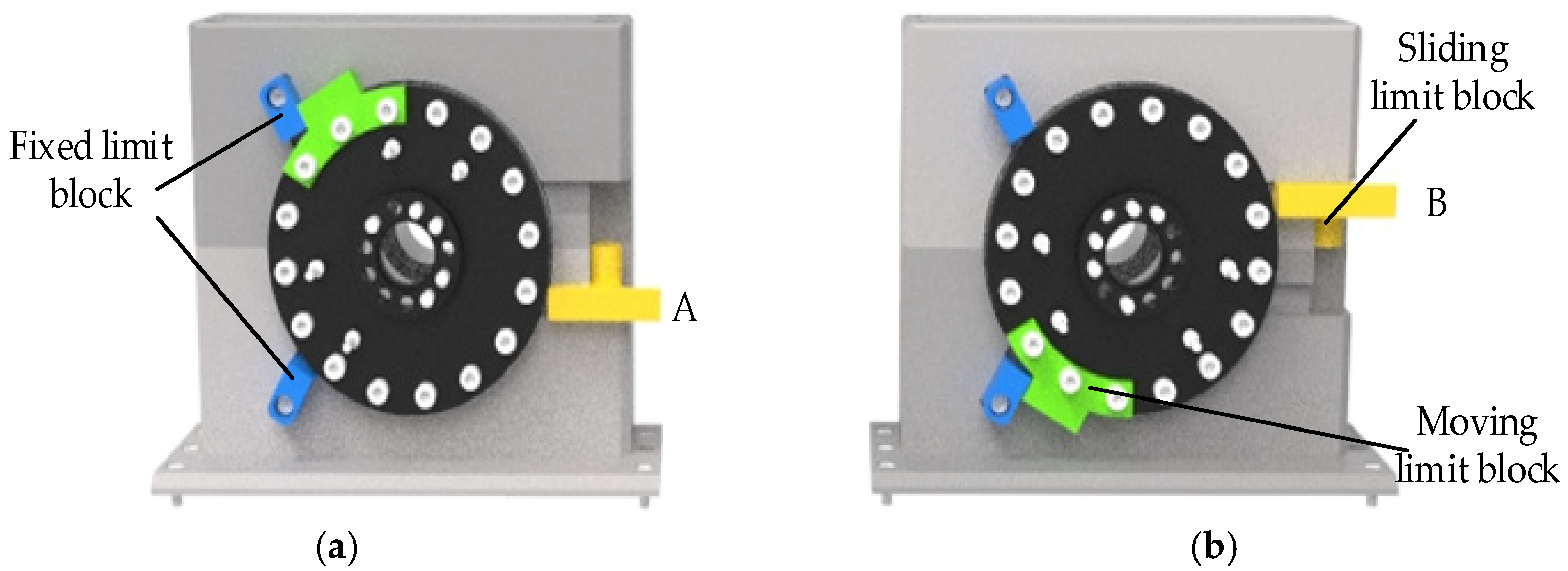
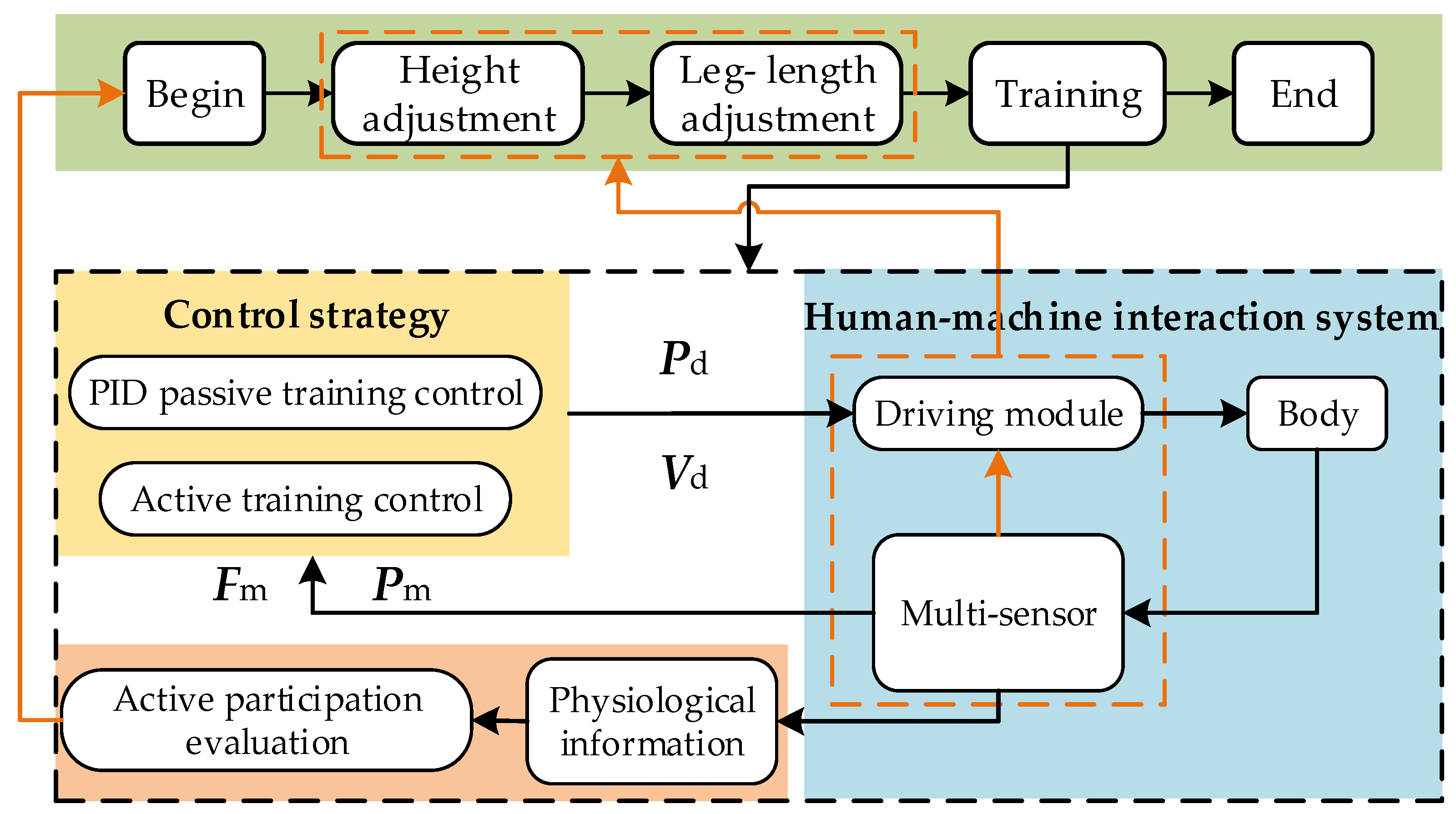
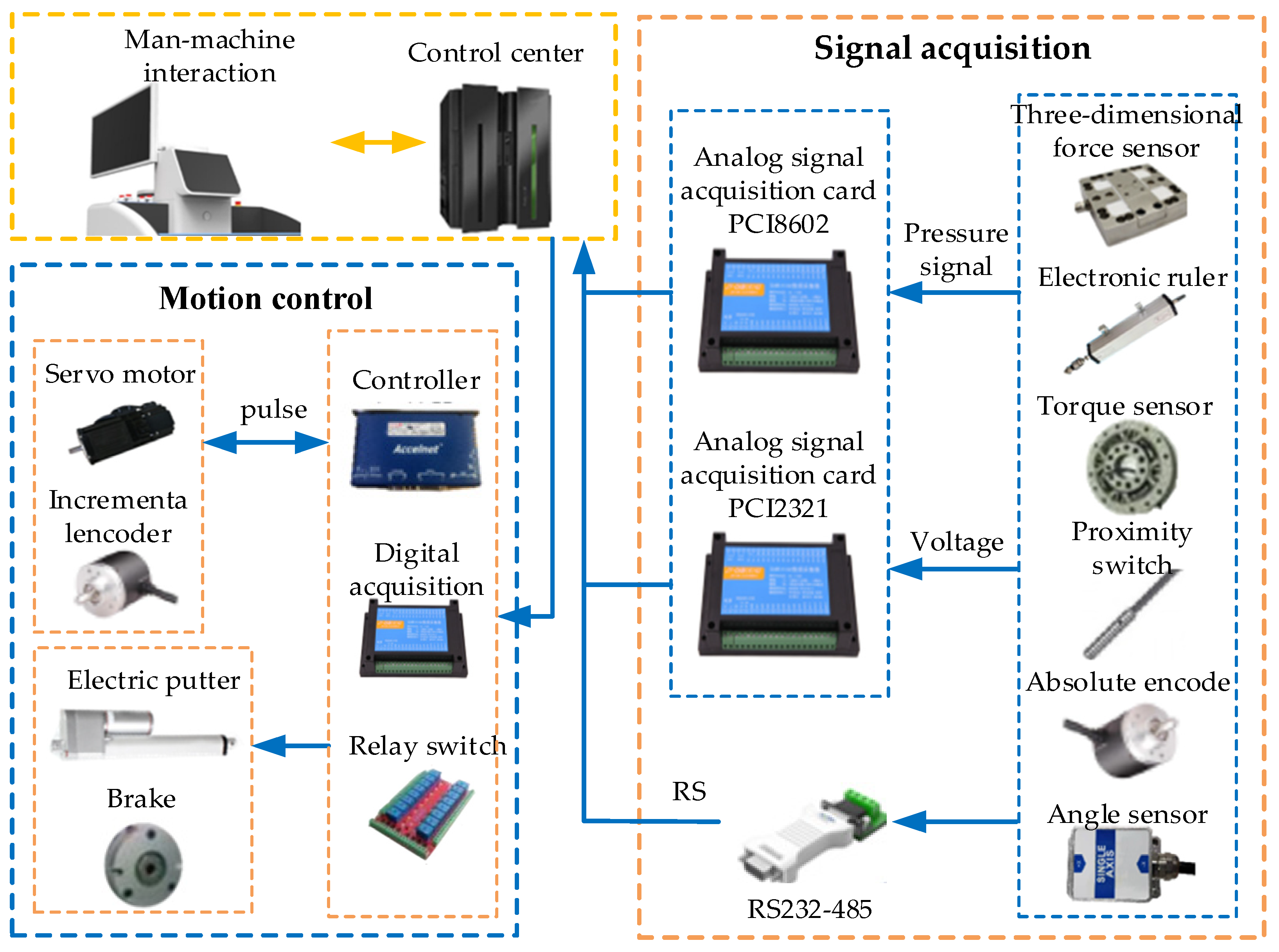
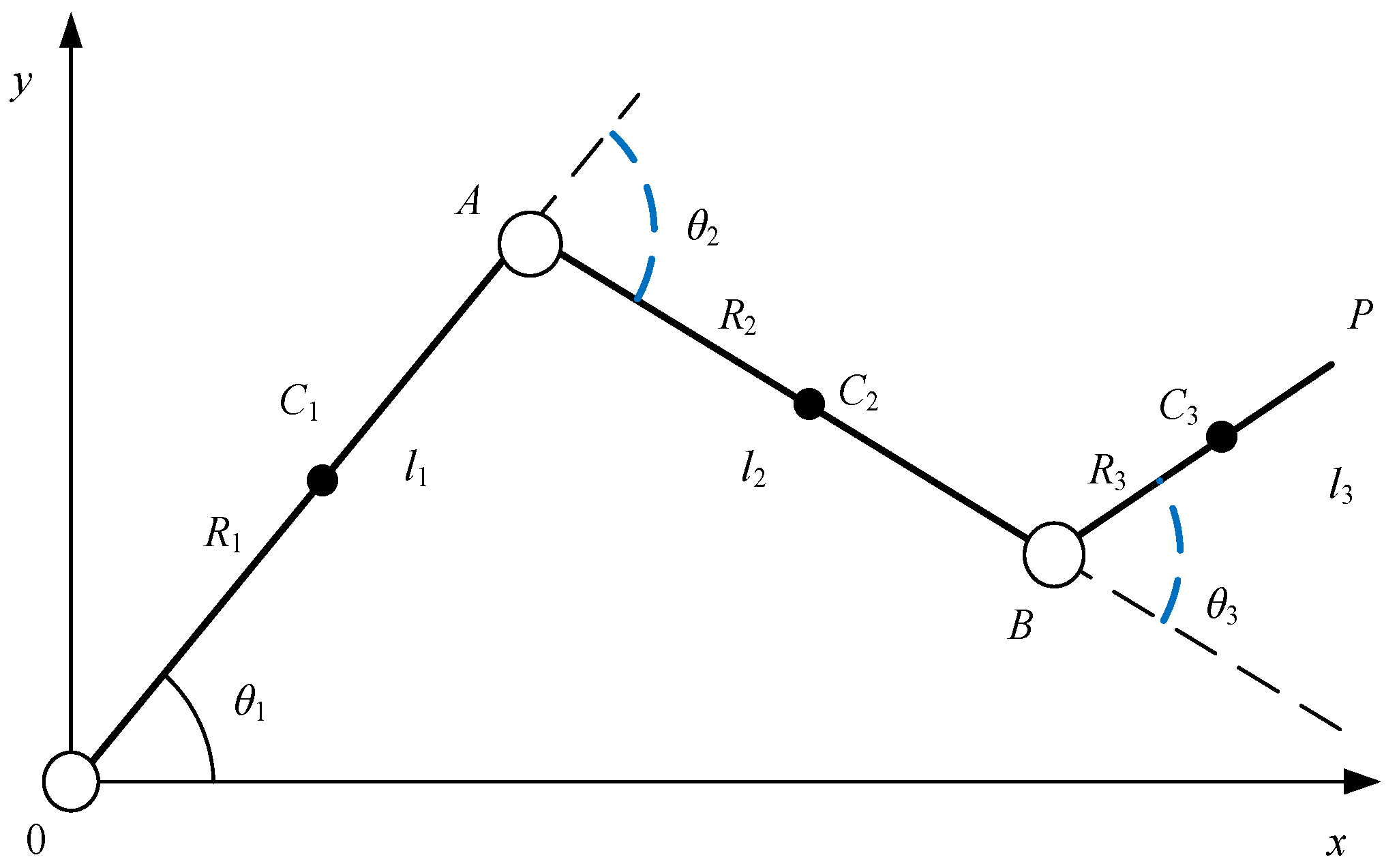
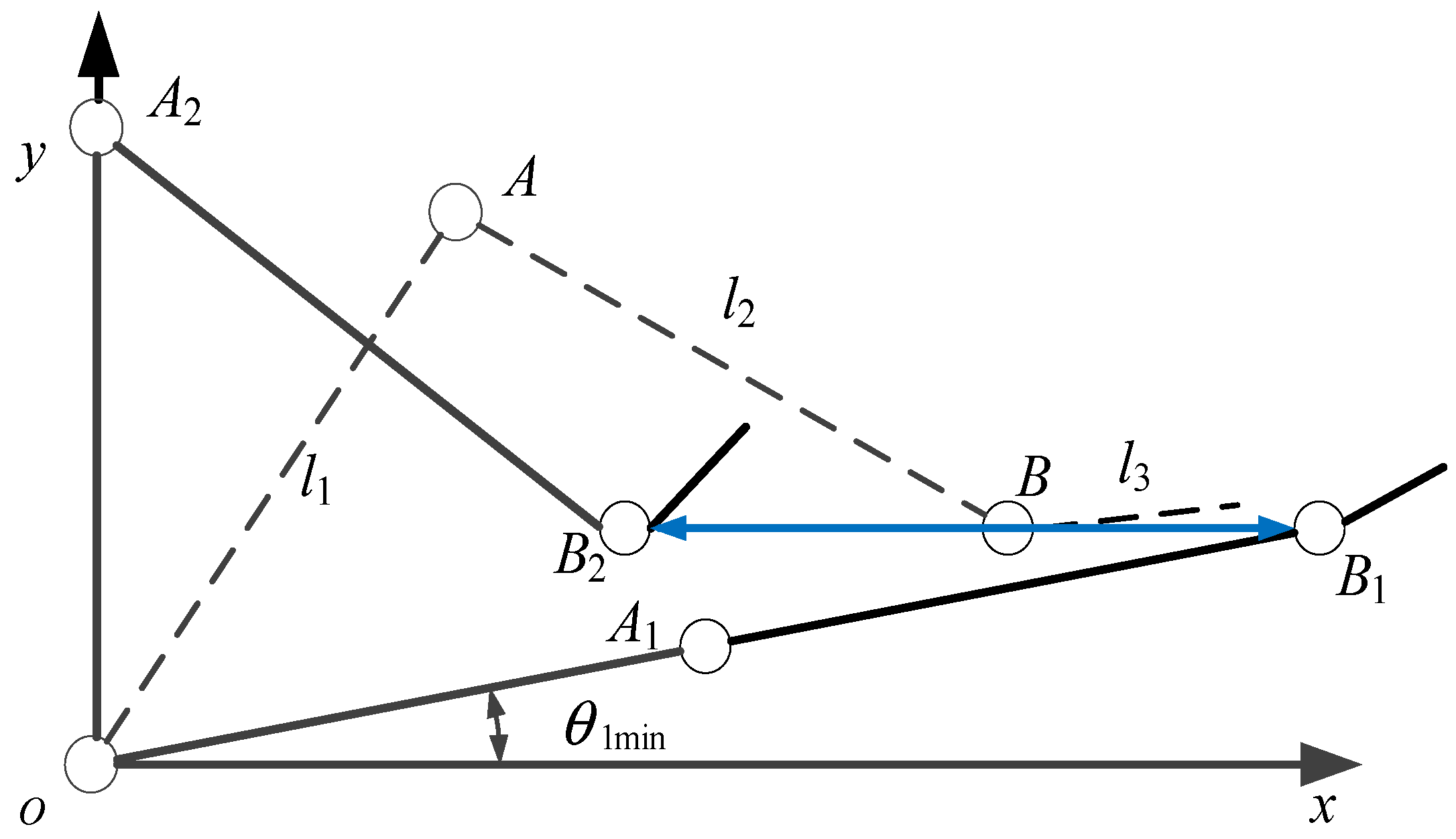
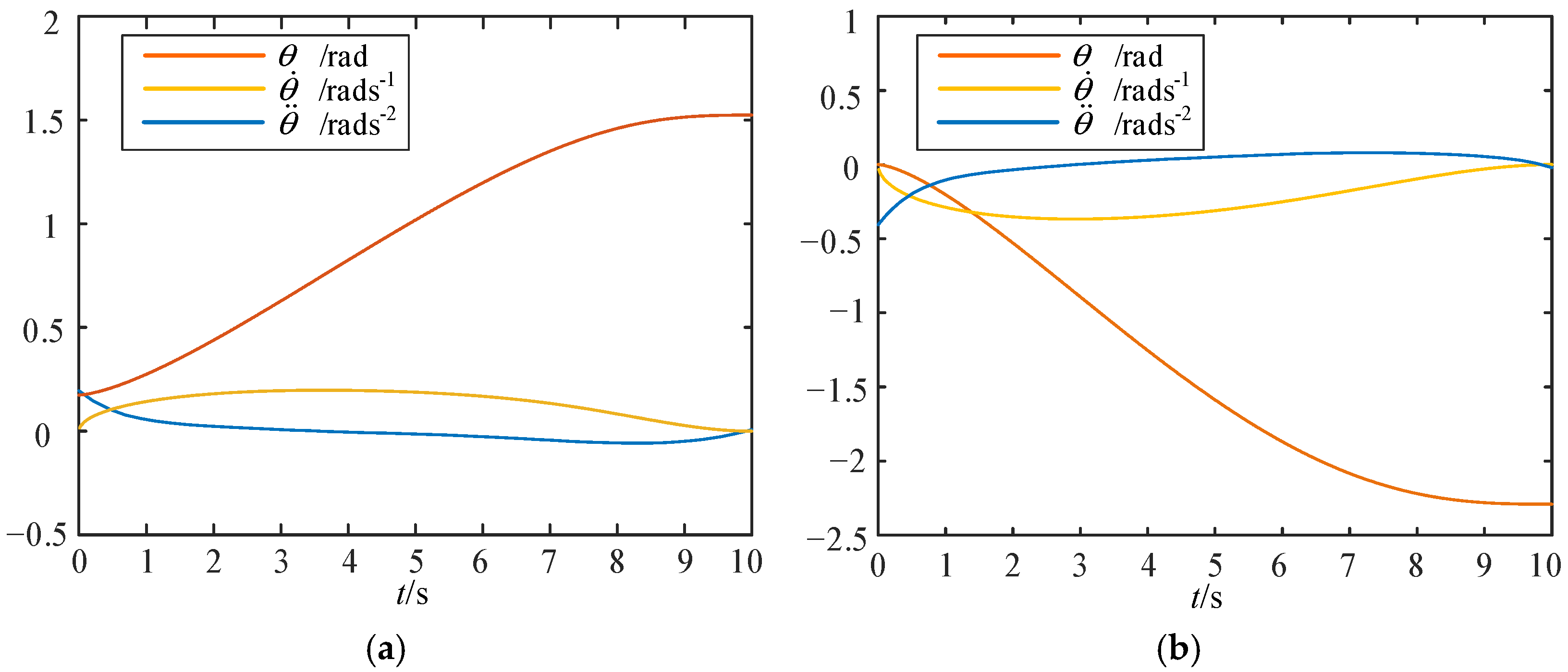
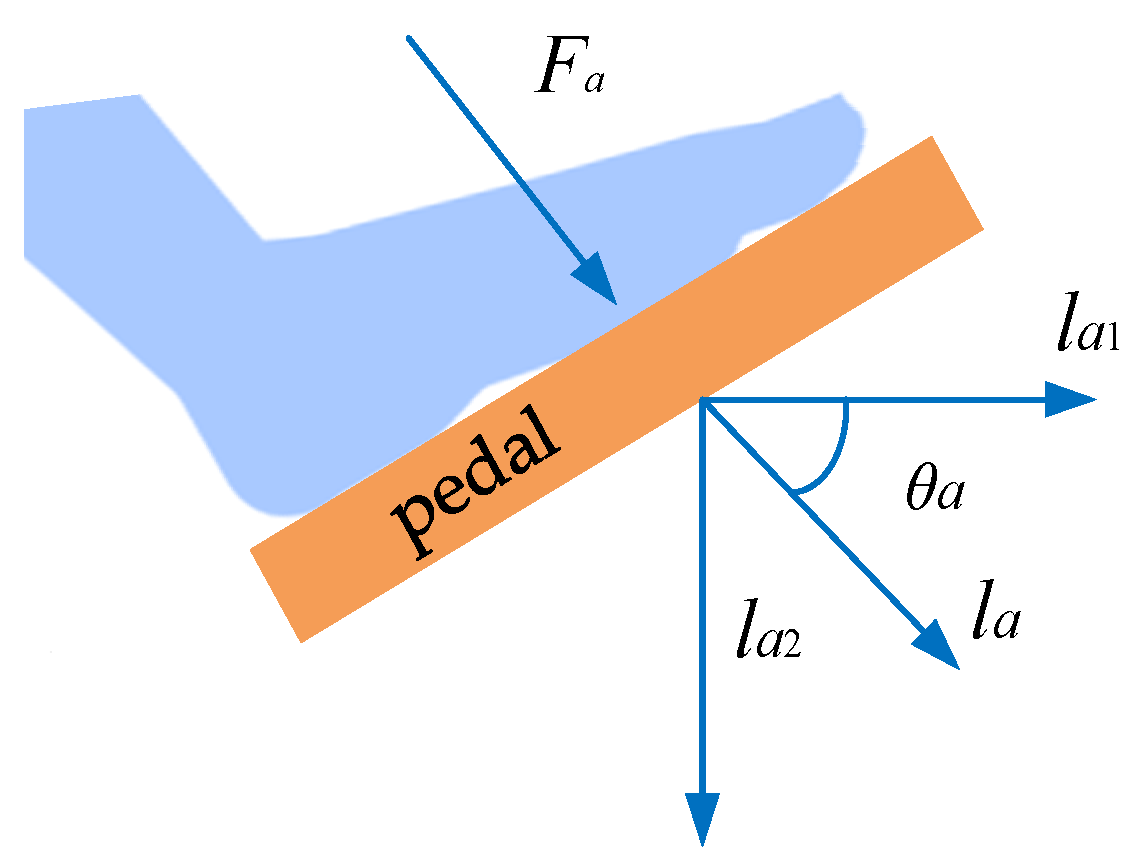

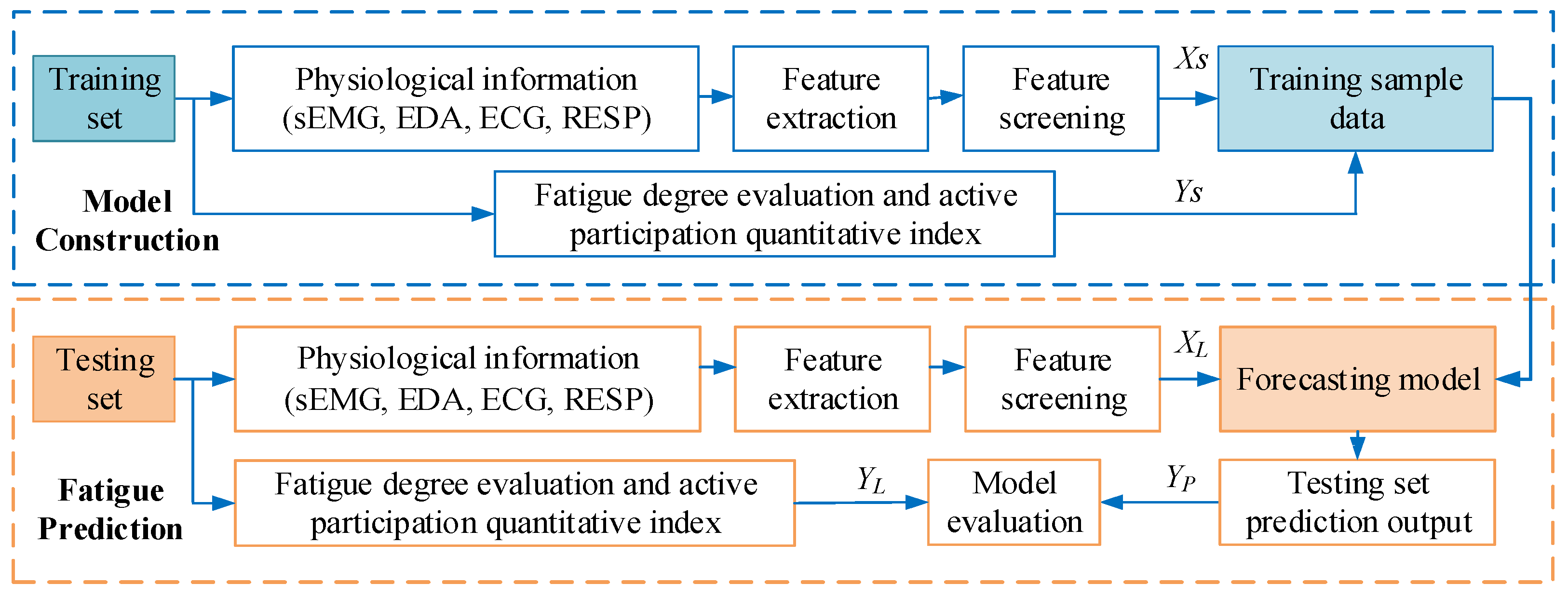
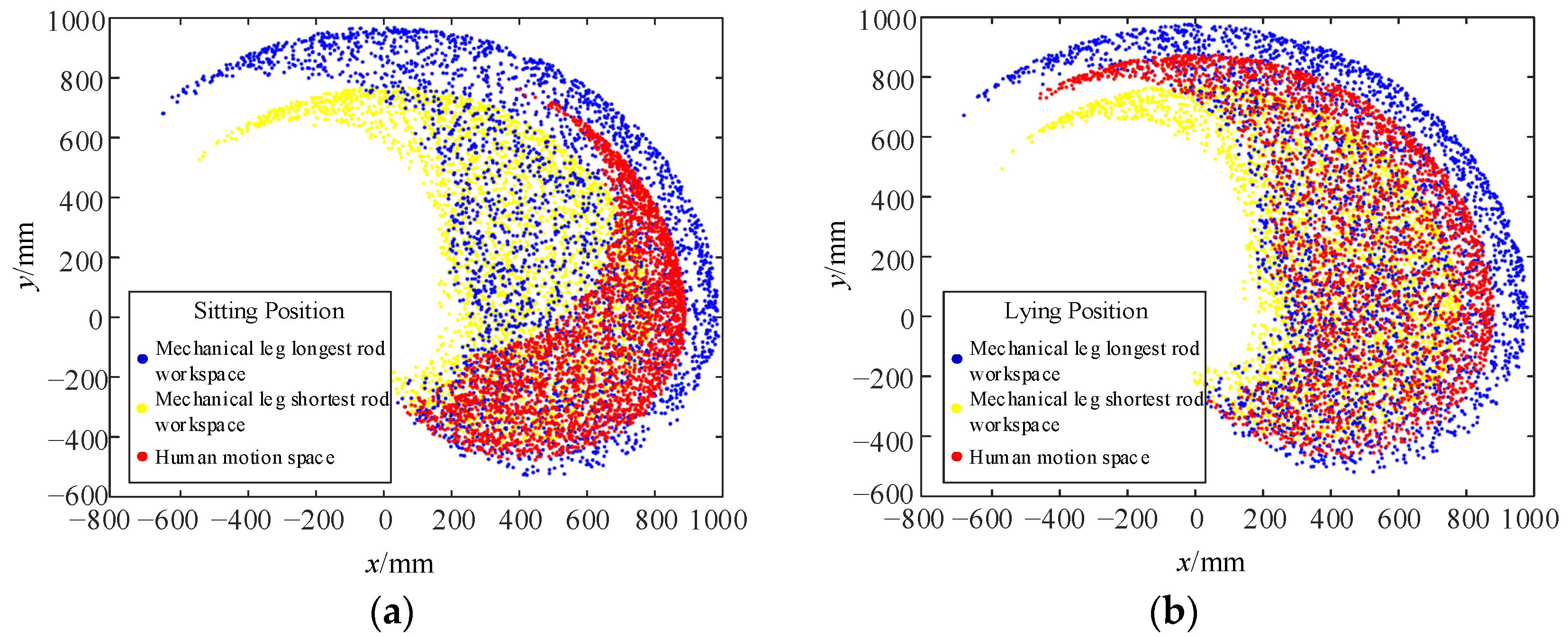
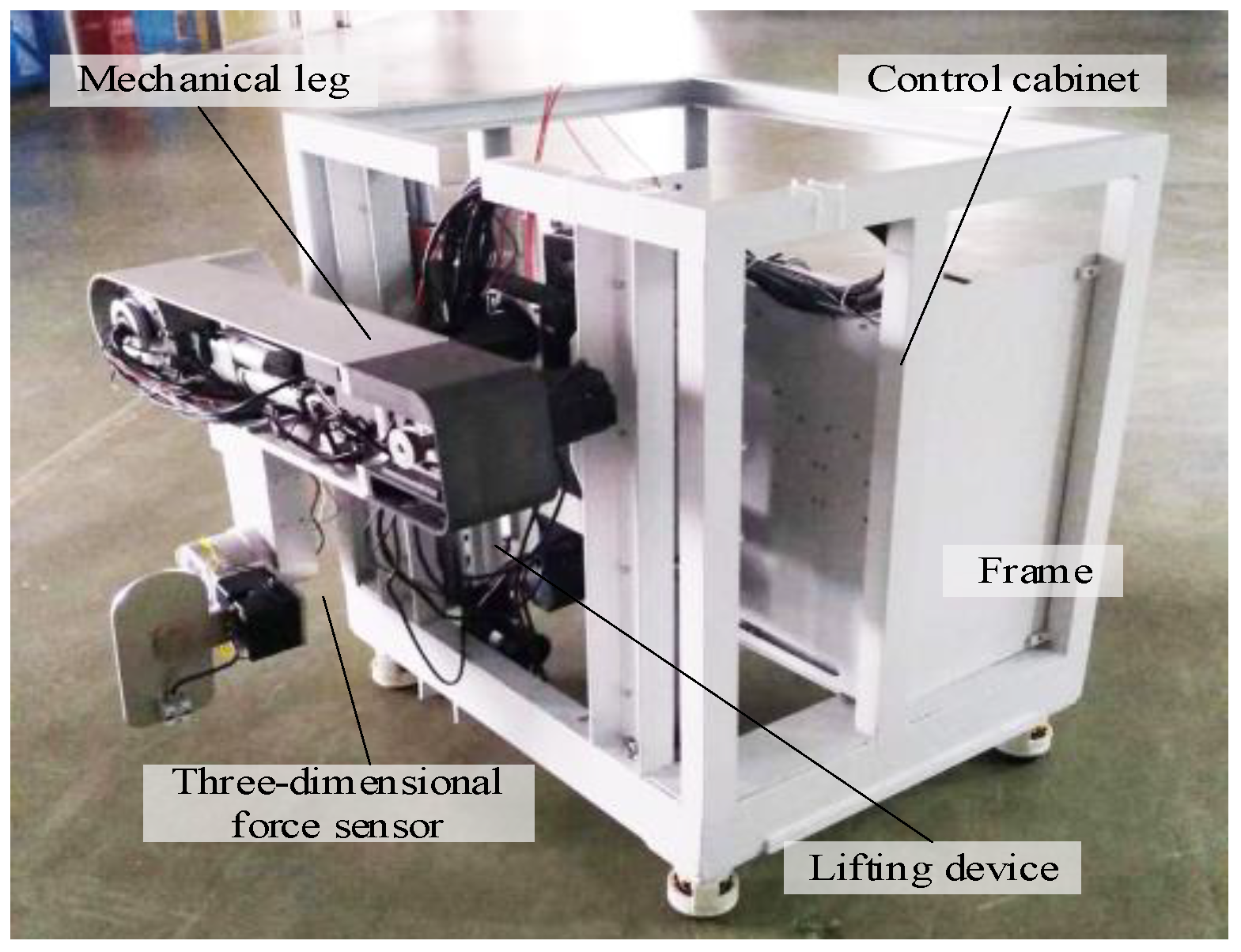
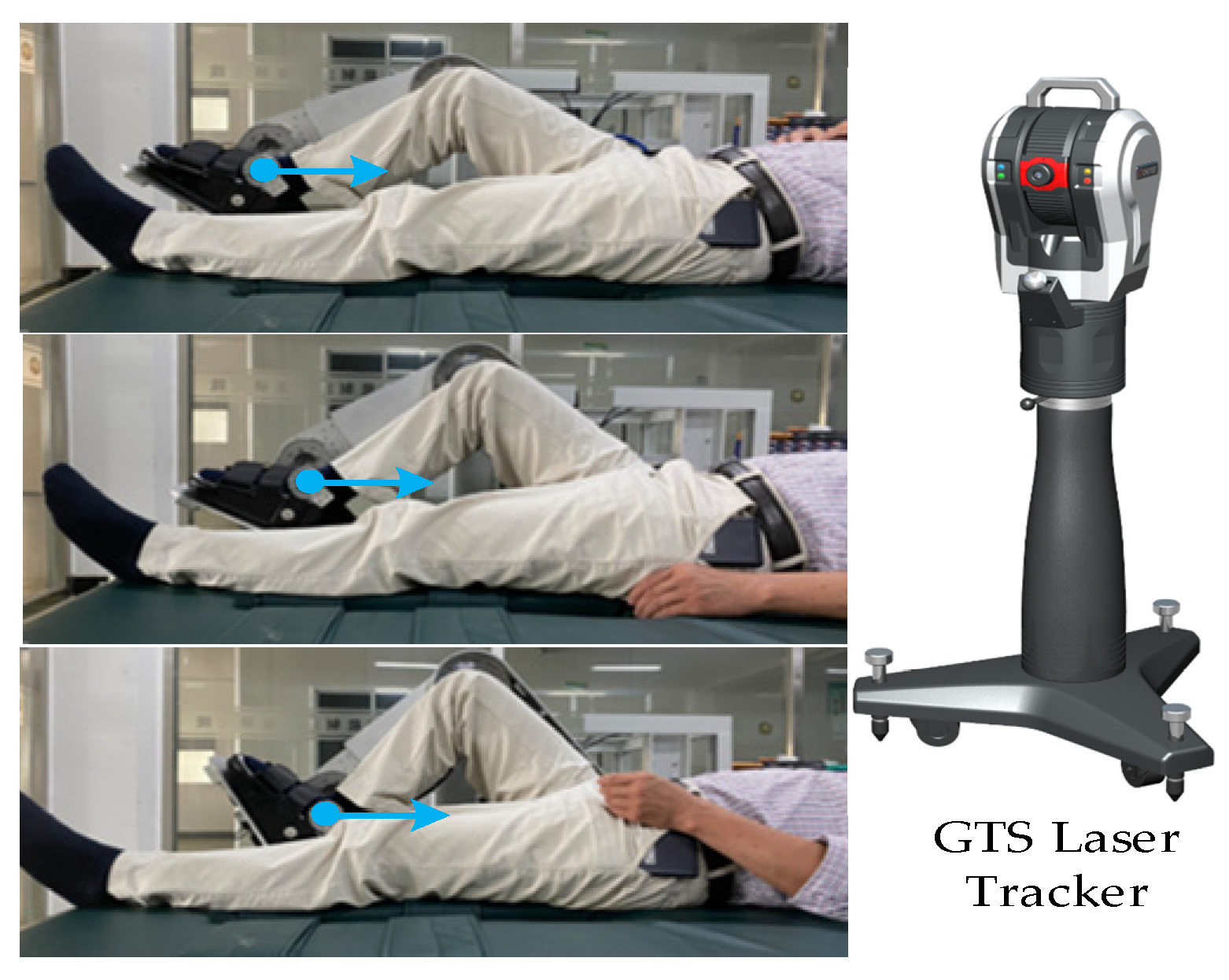
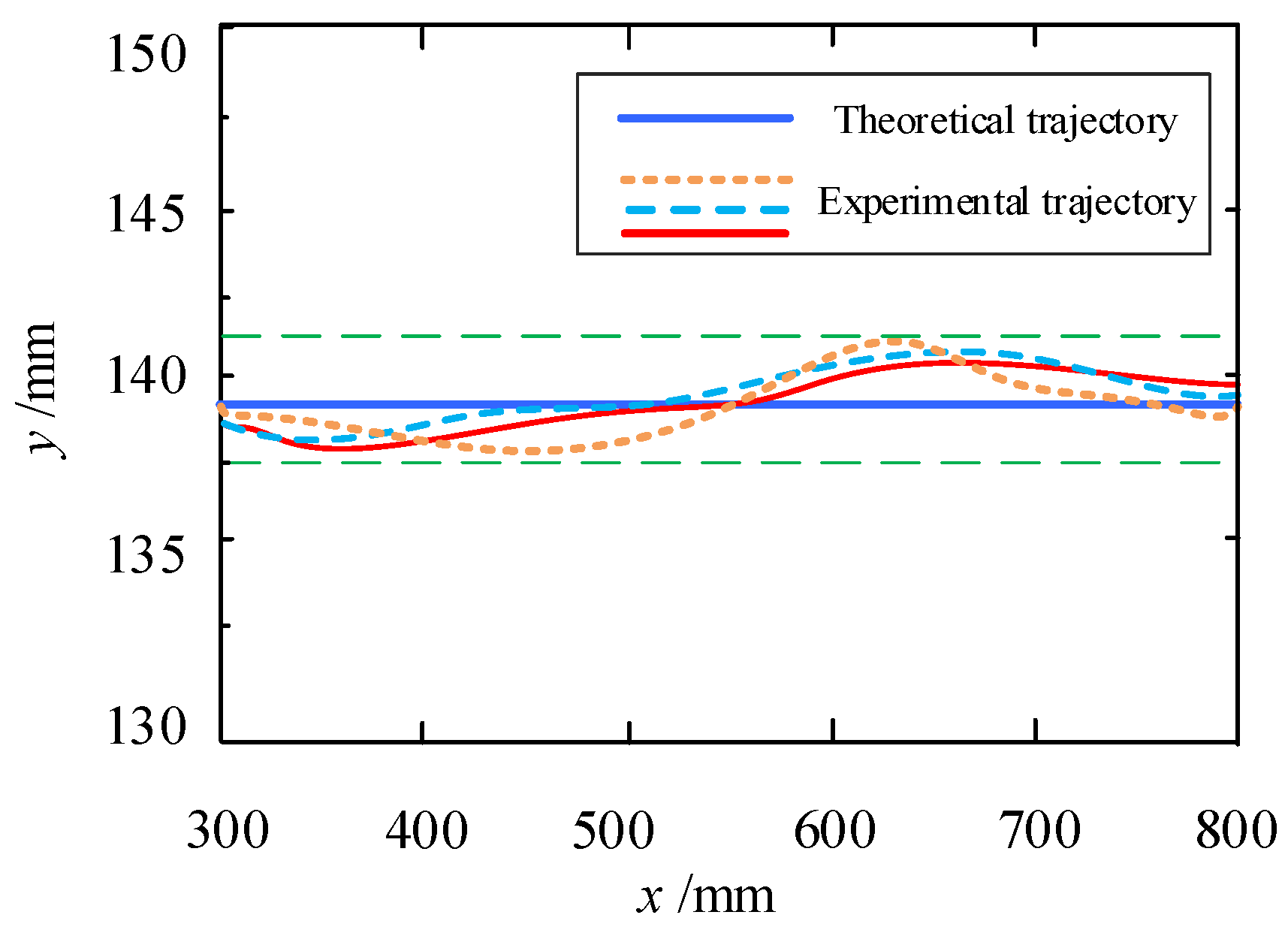
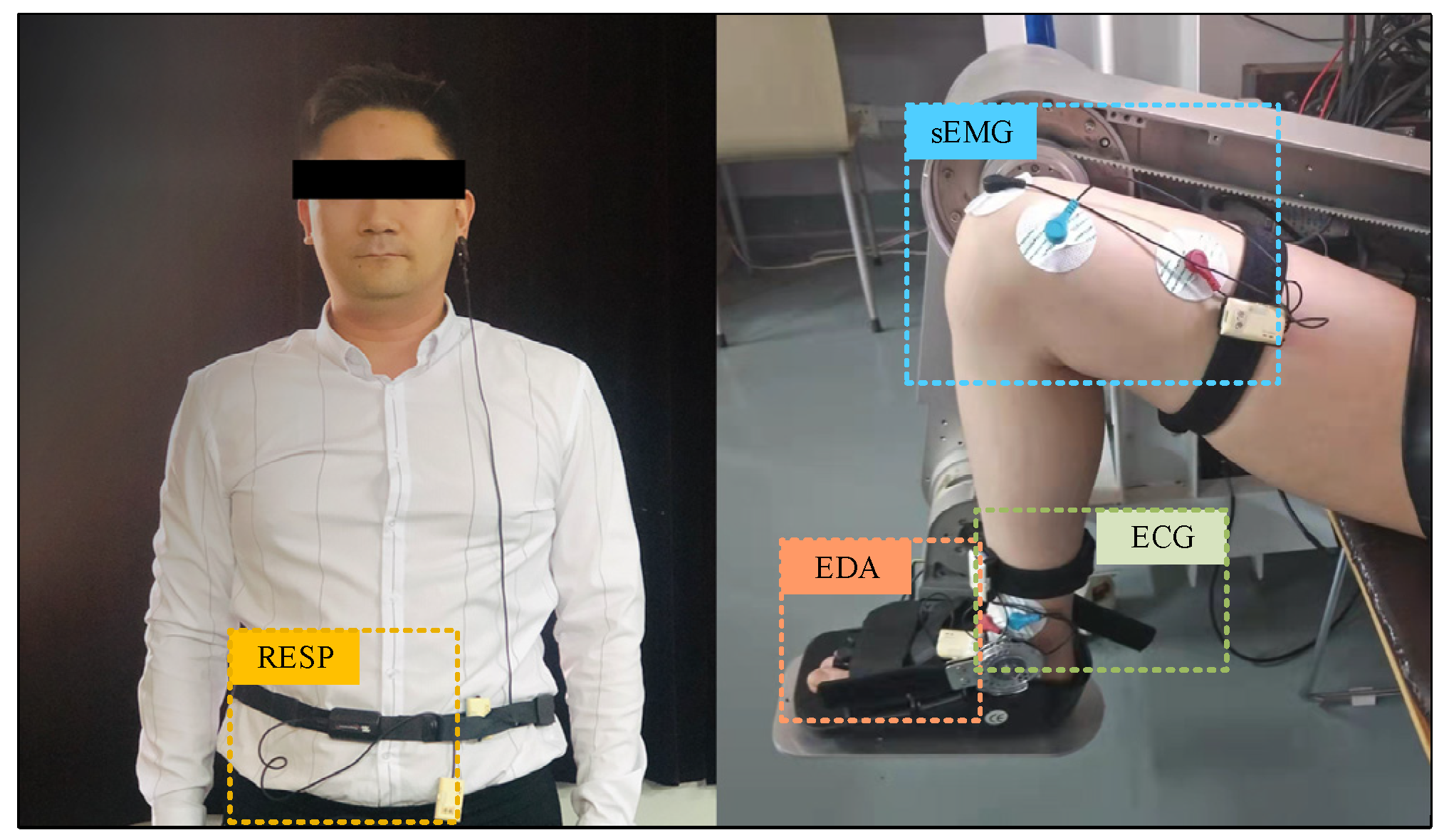
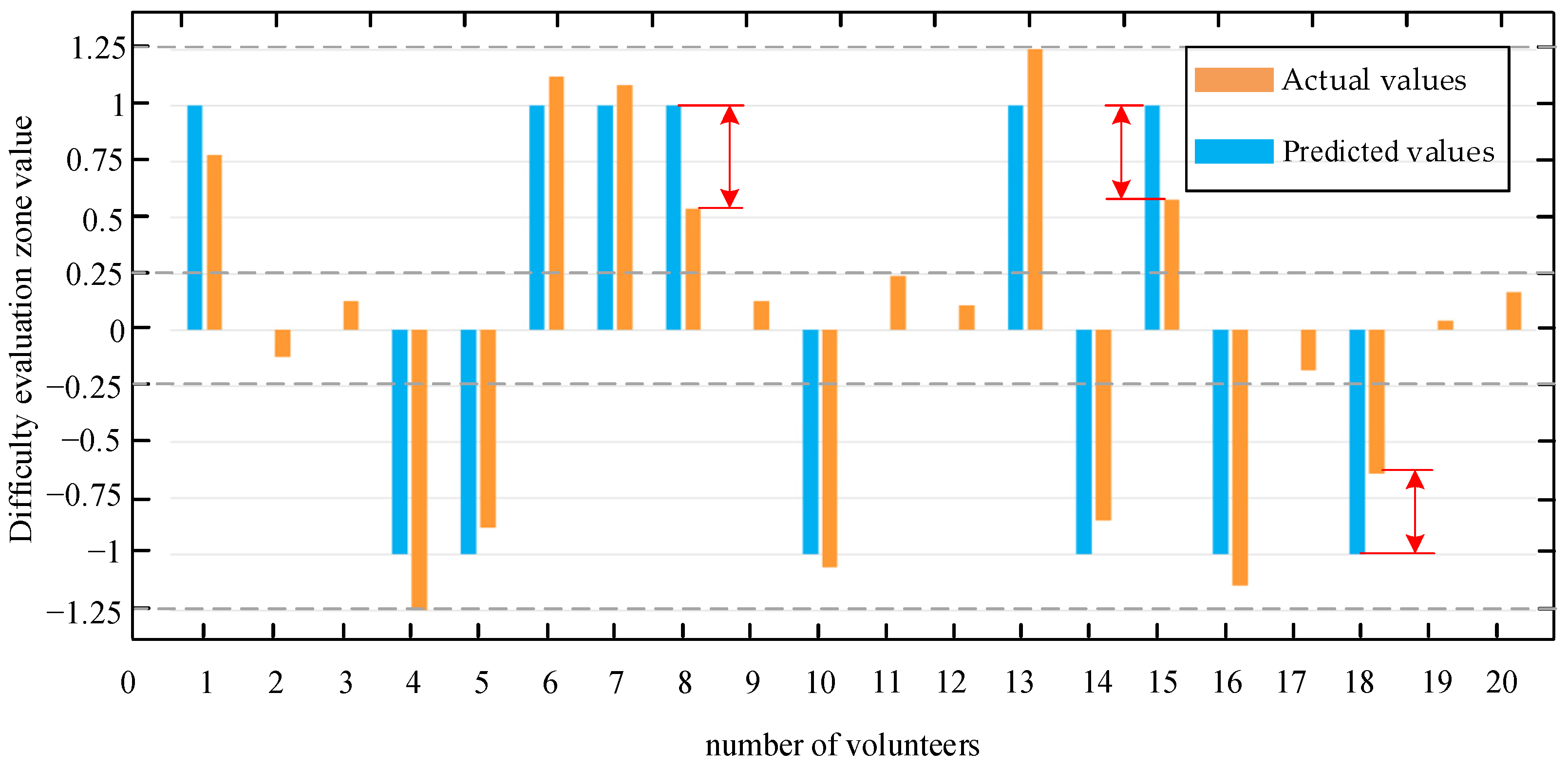
| Features | S-LLRR | Lokomat | Physiotherabot | LR2 | HE-LRR |
|---|---|---|---|---|---|
| Type | Exoskeleton | Exoskeleton | Exoskeleton | Terminal traction | Terminal traction |
| Size | Moderate | Large | Large | Moderate | Moderate |
| Single leg/Double legs | Single | Double | Double | Single | Double |
| Leg length adjustment method | By motor | By hand | By hand | × | × |
| Posture | Sitting and lying | Standing | Sitting | Lying | Sitting and lying |
| Usage patterns | Combined with vehicle | Fixed position | Fixed seat | Combined with vehicle | Combined with vehicle |
| Manufacturing cost | Lower | Higher | Higher | Lower | Lower |
| Mobility | Easy | Harder | Harder | Easy | Easy |
| Features | Equations |
|---|---|
| SDNN | |
| RMSSD | |
| iEMG | |
| RMS |
| Unit | Length/mm | The Range of Joint Variables in Sitting Posture/° | The Range of Joint Variables in Lying Posture/° |
|---|---|---|---|
| thigh | 360~460 | 0~60 | 0~125 |
| calf | 320~420 | −140~0 | −140~0 |
| ankle-foot | 100 | −30~45 | −30~45 |
| No. | Sexuality | Height/cm | Thigh Length/mm | Calf Length/mm | Weight/kg |
|---|---|---|---|---|---|
| 1 | male | 170 | 460 | 425 | 68 |
| 2 | male | 189 | 530 | 500 | 65 |
| 3 | female | 156 | 410 | 350 | 48 |
| Object | Position | RF Channel | Sampling Rate | Magnification |
|---|---|---|---|---|
| sEMG | quadriceps | 2.44 GHz | 2048 Hz | 2000 |
| ECG | ear lobe | 2.44 GHz | 512 Hz | 2000 |
| EDA | toe | 2.44 GHz | 64 Hz | 2000 |
| RESP | abdomen | 2.44 GHz | 64 Hz | 2000 |
Disclaimer/Publisher’s Note: The statements, opinions and data contained in all publications are solely those of the individual author(s) and contributor(s) and not of MDPI and/or the editor(s). MDPI and/or the editor(s) disclaim responsibility for any injury to people or property resulting from any ideas, methods, instructions or products referred to in the content. |
© 2023 by the authors. Licensee MDPI, Basel, Switzerland. This article is an open access article distributed under the terms and conditions of the Creative Commons Attribution (CC BY) license (https://creativecommons.org/licenses/by/4.0/).
Share and Cite
Yu, H.; Zheng, S.; Wu, J.; Sun, L.; Chen, Y.; Zhang, S.; Qin, Z. A New Single-Leg Lower-Limb Rehabilitation Robot: Design, Analysis and Experimental Evaluation. Machines 2023, 11, 447. https://doi.org/10.3390/machines11040447
Yu H, Zheng S, Wu J, Sun L, Chen Y, Zhang S, Qin Z. A New Single-Leg Lower-Limb Rehabilitation Robot: Design, Analysis and Experimental Evaluation. Machines. 2023; 11(4):447. https://doi.org/10.3390/machines11040447
Chicago/Turabian StyleYu, Hongfei, Siyuan Zheng, Jiantao Wu, Li Sun, Yongliang Chen, Shuo Zhang, and Zhongzhi Qin. 2023. "A New Single-Leg Lower-Limb Rehabilitation Robot: Design, Analysis and Experimental Evaluation" Machines 11, no. 4: 447. https://doi.org/10.3390/machines11040447
APA StyleYu, H., Zheng, S., Wu, J., Sun, L., Chen, Y., Zhang, S., & Qin, Z. (2023). A New Single-Leg Lower-Limb Rehabilitation Robot: Design, Analysis and Experimental Evaluation. Machines, 11(4), 447. https://doi.org/10.3390/machines11040447





